Atletico Madrid welcomed Getafe to the Estadio Wanda Metropolitano with a team featuring three debutants as they faced starting a new era with the unwelcome visit of a side who became notoriously hard to beat on their route to a return to European football last season.
In the end, as could have been expected between two sides built on defensive principles, the tie was settled by a single goal as Alvaro Morata headed home from a Kieran Trippier cross in the first half. Red cards for Jorge Molina and Renan Lodi made for an intriguing battle, with Morata missing a second-half penalty, but the three points went to the hosts to get their 2019/20 La Liga campaign off on the right foot.
This tactical analysis will consider how both Atletico Madrid and Getafe performed in this hard-fought battle in eastern Madrid on Sunday evening which ended in a 1-0 home win. The analysis will use statistics to prove how Diego Simeone’s men came out on top on the tactics board as well as on the field of play.
Line-ups
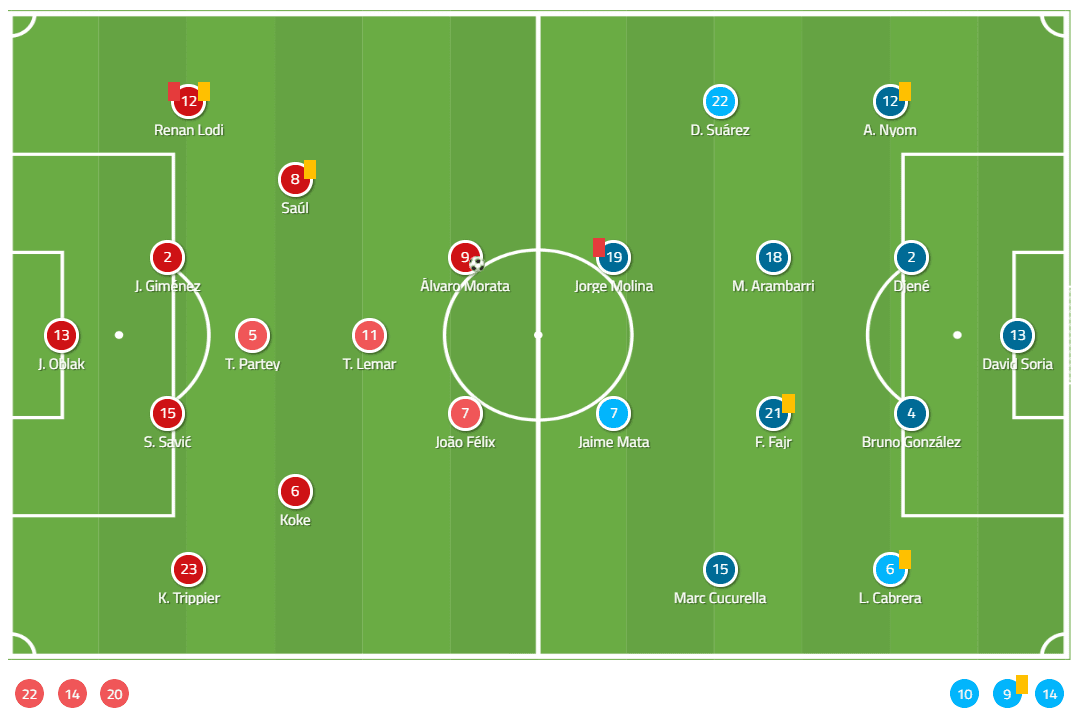
Simeone tweaked his tactics for this tie, primarily to accommodate Joao Felix into the side. He looking to change the shape of his team, from a more traditional and rigid 4-4-2 to a more liberal 4-3-1-2. Thomas Partey got the nod ahead of Marcos Llorente whilst Stefan Savic continued in defence ahead of Mario Hermoso, both reflecting Simeone’s desire to avoid changing too much too soon.
Jose Bordalas’ line-up involved three new debutants, but largely stuck to the typical structure and set-up that they stuck by last season. Damian Suarez and Allan Nyom teamed up on the right in an interesting selection which was experimented with throughout pre-season.
A new system for Atleti
In the past, Simeone has always stood by a traditional 4-4-2. To some extent, Antoine Griezmann was given a free role, though the midfield bank of four could always be relied upon to bring consistency and reliability. For the first time in a significant amount of time, Simeone looked to experiment in a competitive fixture. The 4-3-1-2 formation he deployed was, in reality, a midfield diamond. Thomas sat at the deepest point, protecting the backline, with Koke and Saul ahead of him. Thomas Lemar was the man at the tip, operating behind Felix and Morata, occasionally rotating with the Portuguese starlet, as can be shown in the below image.
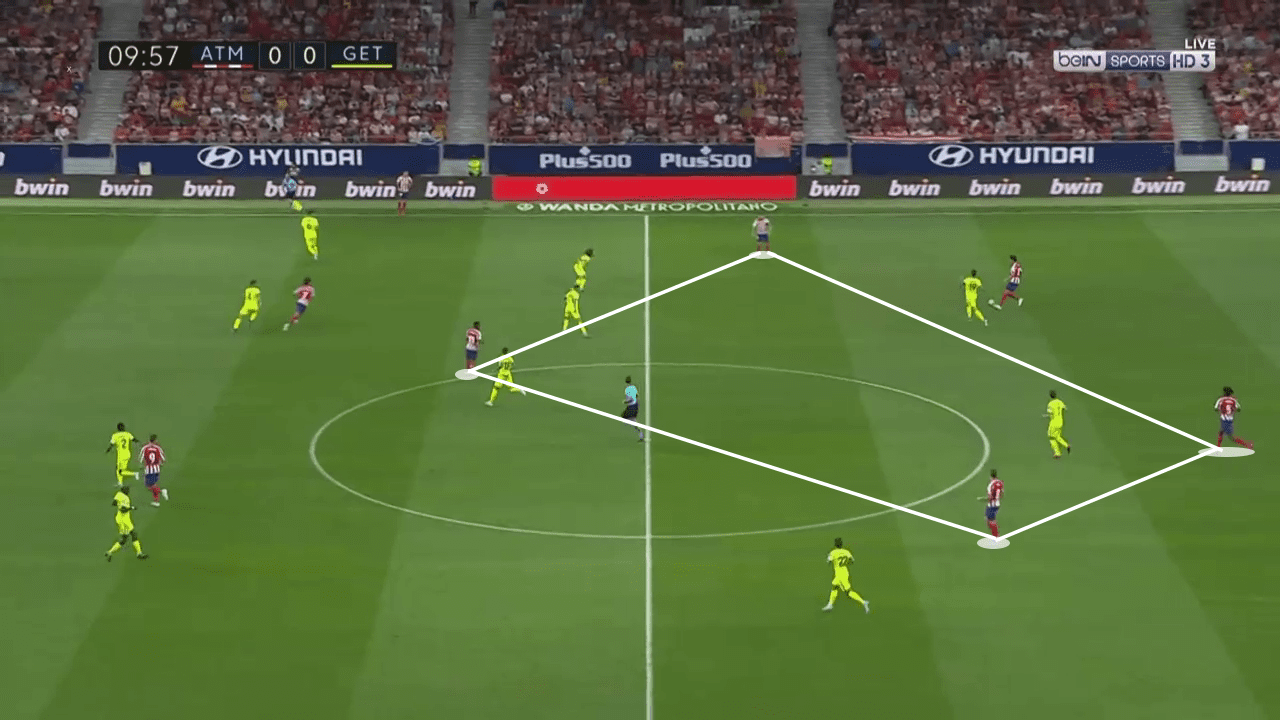
This allowed Atletico to pull Getafe’s midfield around, given their rigid structure in a bank, which immediately became disjointed when they attempted to engage with the Atletico diamond. As soon as one pressed, it would open up space for another Atletico midfielder to move in and take advantage, particularly in the opening stages of an attack as the ball moves out of defence and is brought into attack.
Once Atletico have gained control, it is a different story. As possession is comfortable and Getafe’s press sits back, Atletico change, with the three more offensive midfielders looking to spread into wider roles to give more width. This was a risky approach from Atletico, leaving Thomas as the lone man in the middle, but provided numerous options and was key to overloading Getafe who had set-up specifically to outnumber Atleti out wide and look to force them through the middle.
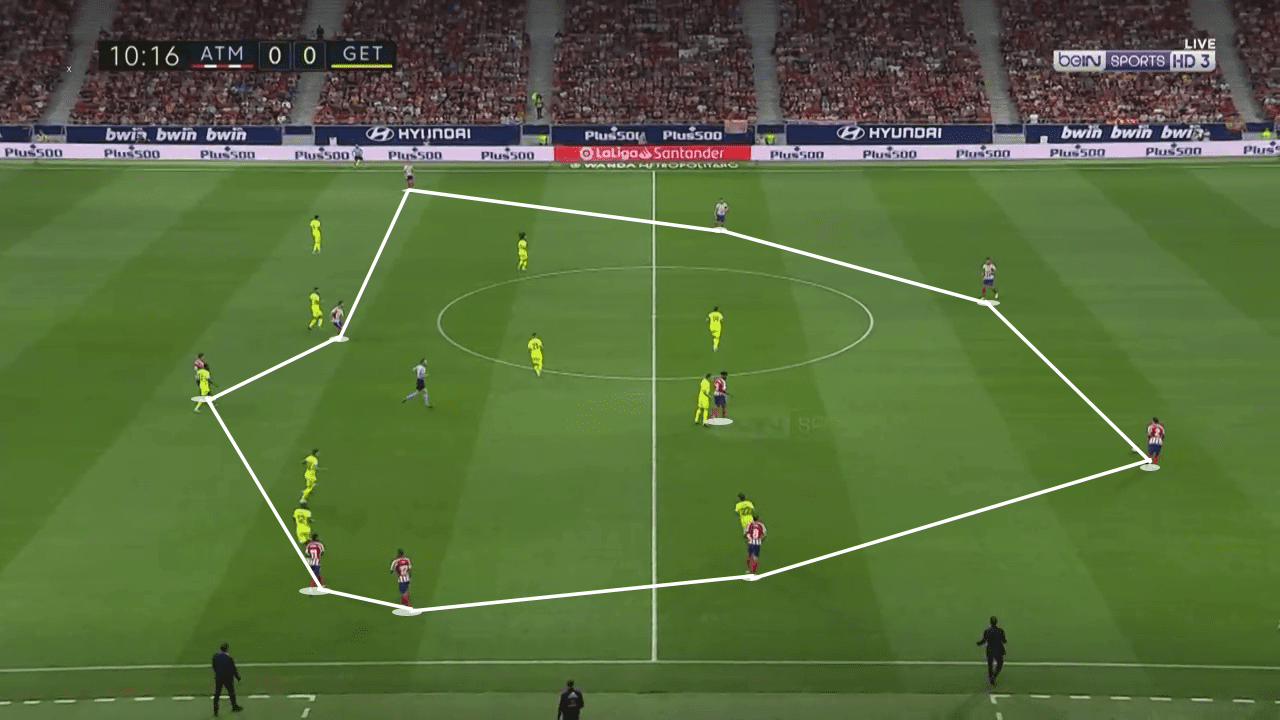
This set-up was essential to Atleti being able to breakthrough when on the attack by bombing down the wings, as was the case when Trippier set up Morata to score. The fitness displayed to rapidly transition from central dominance to exploiting space out wide was impressive, particularly for the first game of the season, and Simeone may find that the challenge will be to maintain that intensity throughout a full campaign.
Bordalas’ curious double full-back set-up
As previously mentioned, Getafe had set-up to attempt to block this approach. By deploying both Suarez and Nyom on the right, they used two full-backs in order to be able to double up and track the free-moving forwards and wingers of Atletico without being dragged out of position. One would mark the winger, typically Lemar drifting to the left, but occasionally Saul or the advancing Lodi, while the other would follow the central runner, either Lemar or Felix, depending upon their starting position.
It worked well on the left flank, with Nyom effectively advancing to push the threat back as soon as Atletico looked to break through down the left and Suarez covering behind. Nyom was the more active of the two, being involved in seven defensive duels and also engaging in a higher press. As soon as the ball was forced back, usually with Lodi looking back to Jose Maria Gimenez, Nyom would retreat with Suarez regaining his place a wide midfielder to block the midfield from advancing in a similar way.
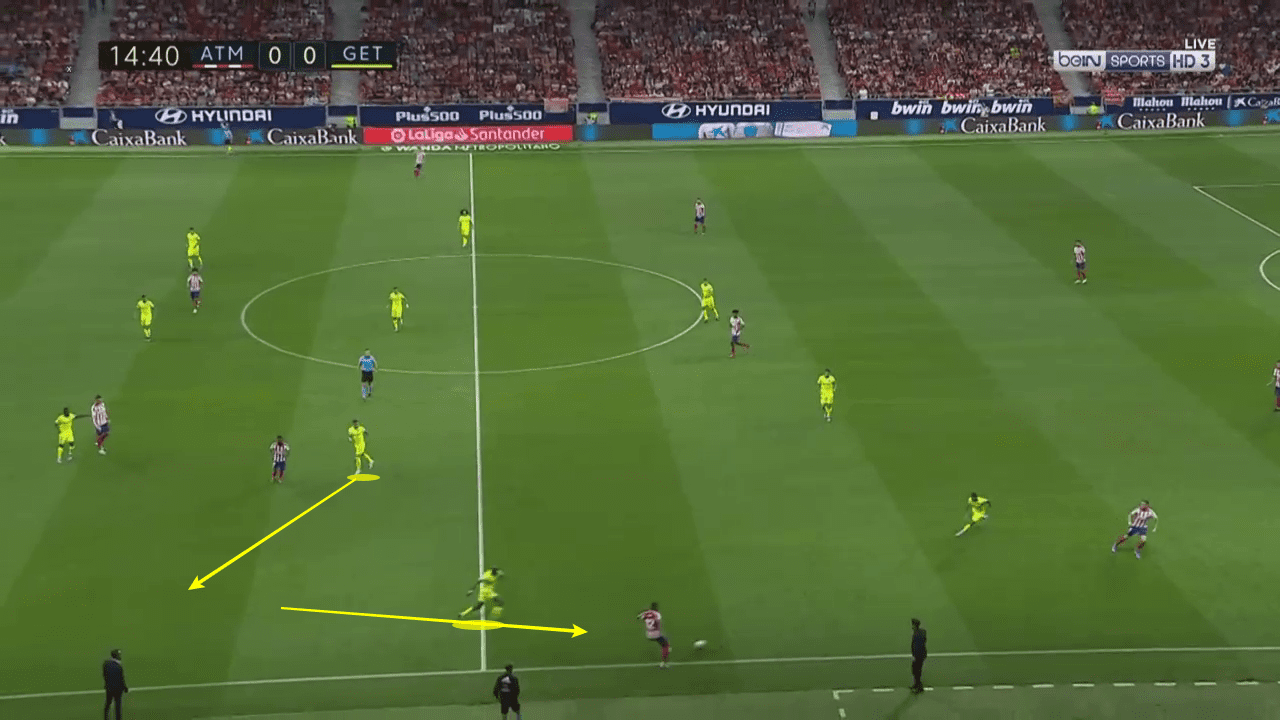
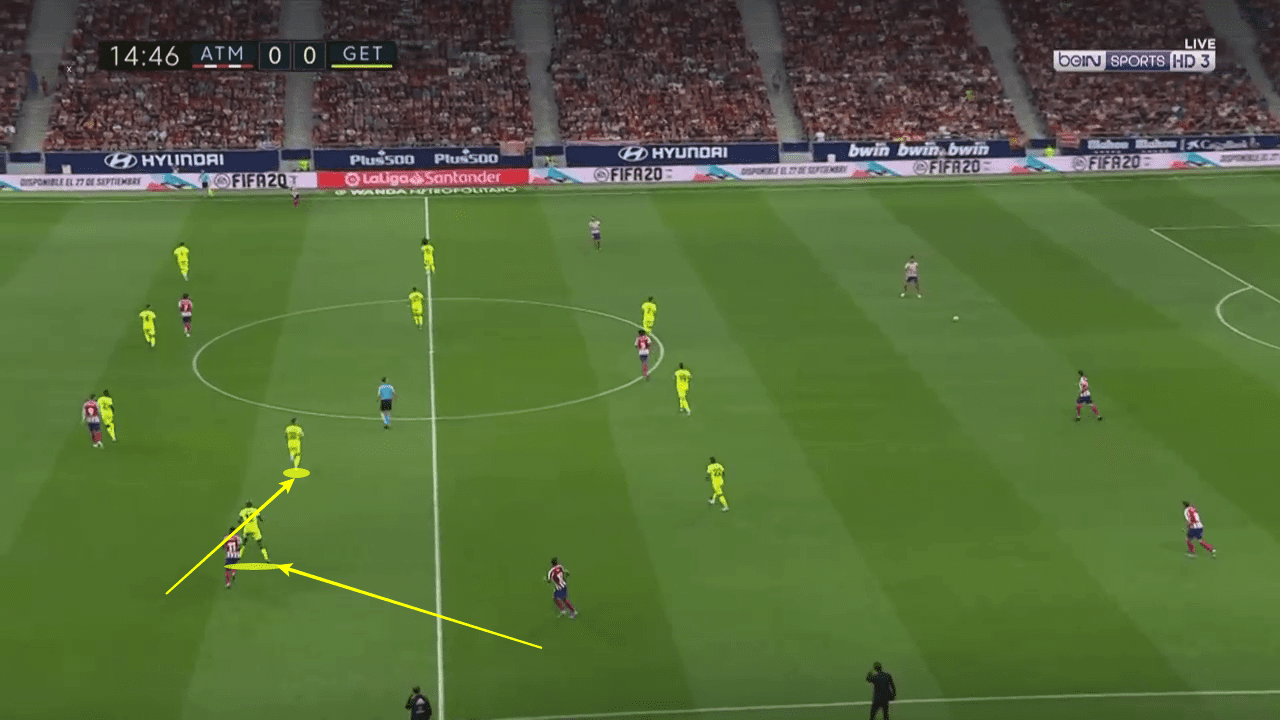
This was not helped by the dismissal to Renan Lodi before half-time for a second bookable offence. With neither Nyom nor Suarez being comfortable on the left, it left two players effectively to mark one man, with Atletico tending to focus on their right, rather than the struggling left flank. It came as no surprise as a result that Suarez was taken off less than 20 minutes into the second half having been involved in just one defensive duel in that time, compared to five in the first half.
How Simeone adapted better to the red cards
With two dismissals in just four minutes, this was always likely to be a turning point in the tie. How both teams reacted would be essential to deciding how the second half would unfold, with both sides settling for a quiet few minutes without probing or testing the opposition until the half-time break gave them a chance to regroup, with Lodi’s dismissal coming in the 42nd minute.
It was Simeone who adapted his team better to the change though, with Saul being the one to regularly drop back and fill in at left-back. It is a role that he played on occasion in 2018/19 and, though not his best, limited the impact on the rest of the side. With Lemar still possessing some freedom in midfield, Koke and Thomas functioned as a double pivot to protect the backline and allow Saul to advance without leaving a substantial gap in behind. Essentially, the core tactics of looking to get down the flanks remained the focus, with Trippier and Saul both being afforded the opportunity to get forwards to provide crosses into the box.
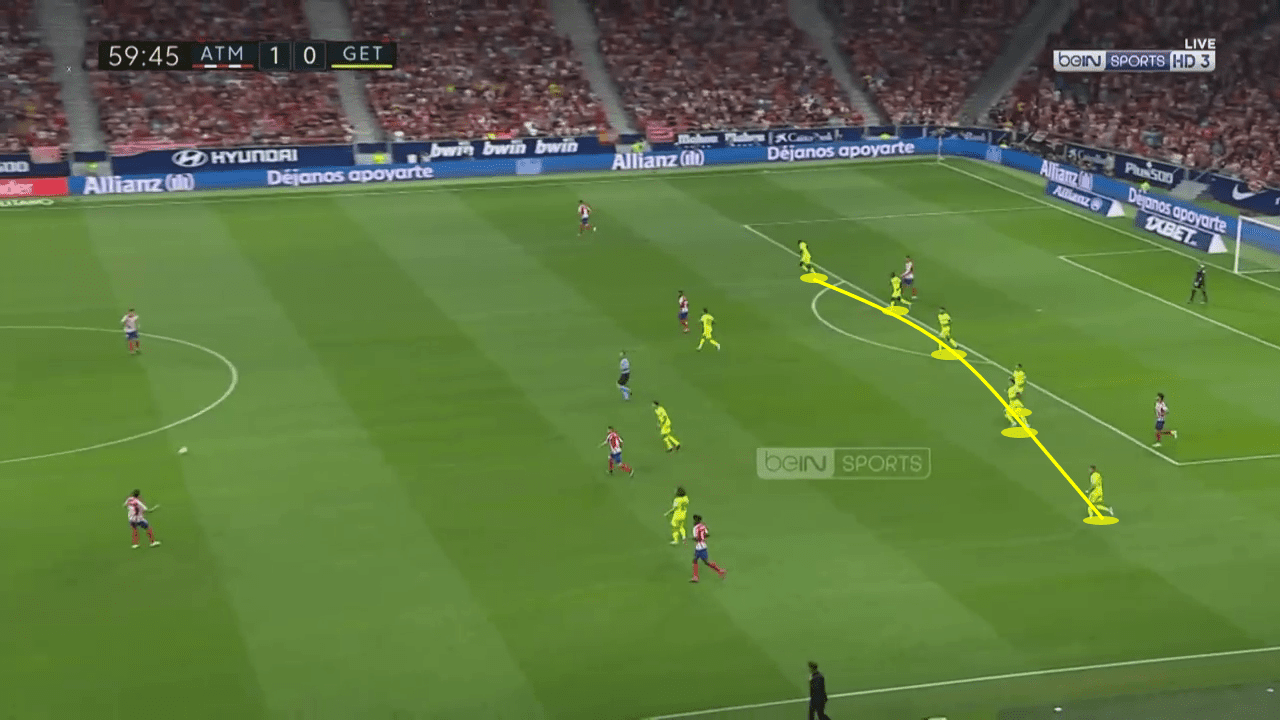
However, most importantly, Getafe decided to cover their backs. Bordalas has at times been accused of lacking ambition and that could have been a fair accusation on Sunday. Getafe were too slow and sluggish in the way that they pushed up when looking to regain possession. In the above example, which was not uncommon, there was a six man defensive line on the edge of their own box. In the front line, Marc Cucurella, Jaime Mata and co. would look to press, but would rarely venture out of even the final third so as to conserve energy and avoid a one man solo mission. This proved to be counterproductive in finding any way out for Getafe, who managed only one chance of note and often struggled to get out of their own half.
Felix’s free role
Atletico’s energy and fitness was not clear just in how they were set-up to defend from the front and execute an effective strategy, but also in the role afforded to Felix. Much like Griezmann before him, he was afforded a free role to float around the pitch as he saw fit to truly express himself and show what he could do. In the second half, it was key to leading to the stunning 60-yard run, nutmeg included, which resulted in winning a penalty which Morata would fail to convert.
As Felix’s pass map represents, although he managed just 15 passes before limping off with an injury after the hour mark, he could be found all over the pitch. That allowed him to help the team to find ways out of tight gaps but also to look to create attacks from deep. Rotating with Lemar, he could do so without being concerned about leaving Morata isolated. The former Real Madrid man was happy to lead the line and look to get on the end of crosses and show his poachers’ instinct, with Felix playing a deeper role to influence the game and begin the attacking transition.
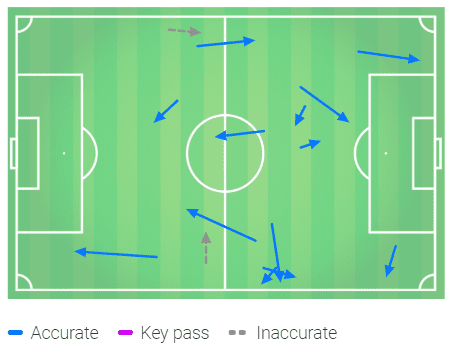
A final factor shown here is that Felix was not afraid to get stuck in with the defensive side of the game. The 19-year-old won all of his defensive duels and, though they were not frequent, did not shy away from them. He continued to drop deep to support his team-mates and to provide the quick breakaway from a deep position. Almost half of his passes were forwards, helping to push the team into more advanced positions and provide a fundamental outlet.
Conclusion
This is perhaps the most exciting start to a season for some time for Simeone’s men. Organised in defence, creative in midfield and clinical in attack, it was a performance of great energy and initiative which shows potential. Avoiding injuries to what remains a shallow squad will remain a challenge with such a high intensity, but should the coach achieve it, he will be expected to aim high with this young squad of players who already appear to be integrating well into his system.
Bordalas and his team should not be disheartened by this display. In challenging circumstances, they managed to limit the scoreline and whilst they did not show great ambition, few would expect them to. Getafe reached their position last season by prioritising in this way and, although he won’t admit it, taking points at home against Athletic Club and Alaves in the next two fixtures will be a far higher priority than seeking to wear out his men in a challenge to come back from behind against one of La Liga’s most promising sides.

If you love tactical analysis, then you’ll love the digital magazines from totalfootballanalysis.com – a guaranteed 100+ pages of pure tactical analysis covering topics from the Premier League, Serie A, La Liga, Bundesliga and many, many more. Buy your copy of the August issue for just ₤4.99 here.

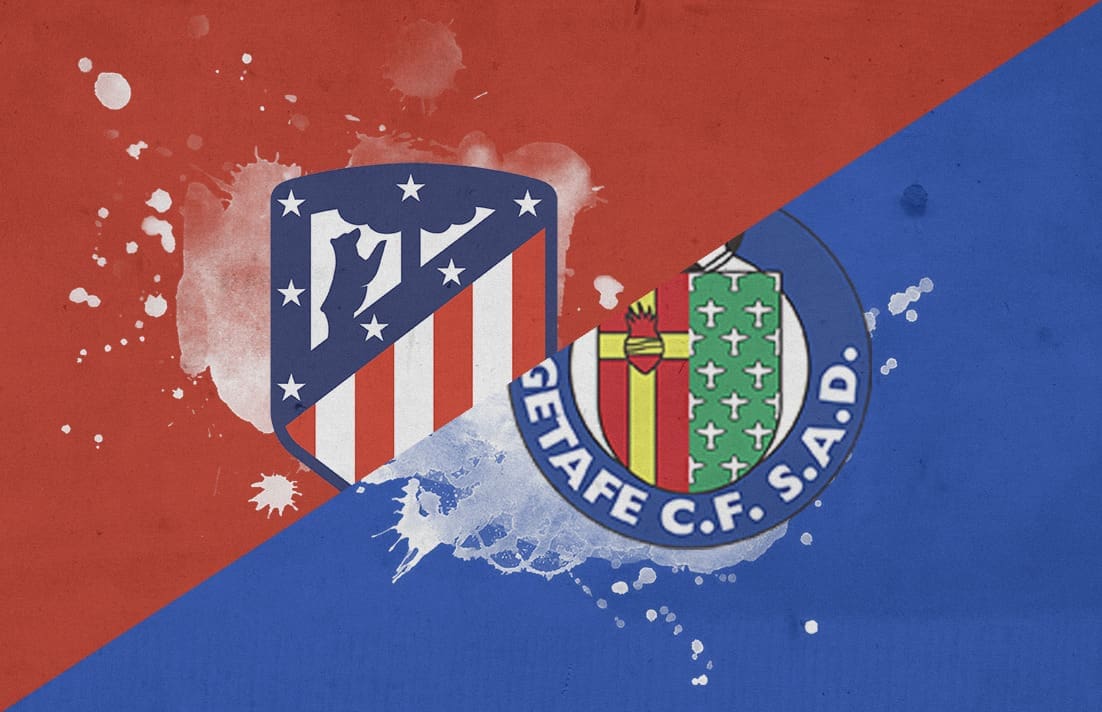


Comments